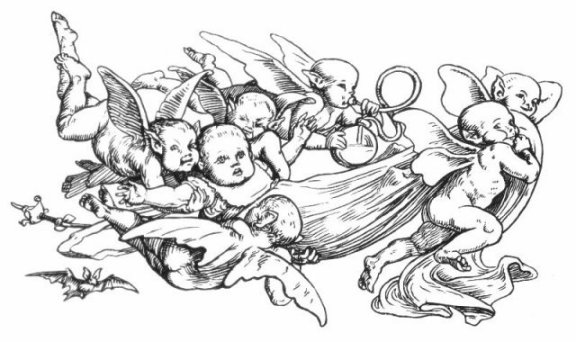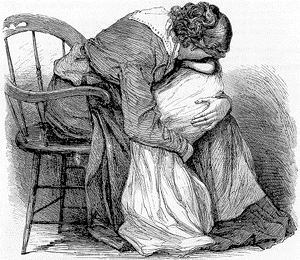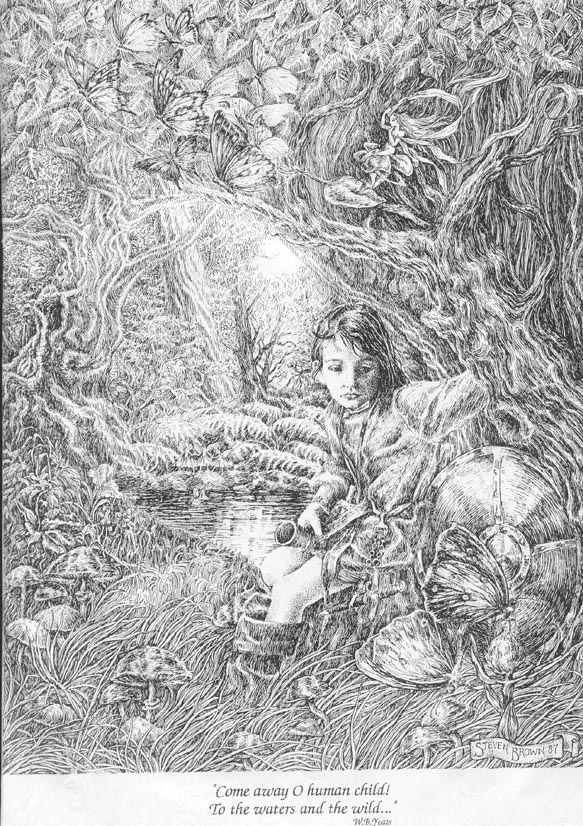 |
| Alexandra Sophie, Pinterest |
 |
| Changeling, Alan Lee 1976 |
 |
| The Elves, by Walter Crane |
"Mentions of the thefts of babies are to be found in the Medieval Chronicles of Ralph of Coggeshall and Gervase of Tilbury among others, through the Elizabethan and Jacobean times, and right down to the beginning of the...(20th) century. The fairies' normal method was to steal an unchristened child, who had not been given proper protection, out of the cradle and to leave a substitute in it's place. This 'changeling' was of various kinds. Sometimes it was a stock of wood roughly shaped into the likeness of a child and endowed by glamour with a temporary appearance of life, which soon faded, when the baby would appear to die and the stock would be duly buried. More often a fairy child who did not thrive would be left behind, while the coveted, beautiful human baby was taken. More often still the changeling would be an ancient, withered fairy, of no more use to the fairy tribe and willing to lead an easy life being cherished, fed and carried about by its anxious foster-mother, wailing and crying for food and attention in an apparent state of paralysis." --- Katherine Briggs, An Encyclopedia of Fairies
 |
| Puck, Richard Dadd 1840 |
The notion of Faeries entering one's household today is often viewed as childish fancy. The notion or speculation of such things in Medieval Europe had devastating consequences. The Malleus Maleficarum often referred to as The Hammer of the Witches was written by a German Catholic clergyman named Heinrich Kramer in 1486. This treatise on the persecution of witches utilized various folk legends and fear to systematically dispute arguments that claimed witchcraft did not exist. The book accounted for a wide variety of superstition including that of the changeling myth. The contents written by Heinrich Kramer are as follows:
Malleus Maleficarum Part 2
Chapter VIII
Certain Remedies prescribed against those Dark and Horrid Harms with which Devils may Afflict Men.
But with regard to the former kind of injury we may quote S. Thomas, the Second of the Second, Question 90, where he asks whether it is lawful to adjure an irrational creature. He answers that it is; but only in the way of compulsion, by which it is sent back to the devil, who uses irrational creatures to harm us. And such is the method of adjuration in the exorcisms of the Church by which the power of the devil is kept away from irrational creatures. But if the adjuration is addressed to the irrational creature itself, which understands nothing, then it would be nugatory and vain. From this it can be understood that they can be driven off by lawful exorcisms and adjurations, the help of the Divine mercy being granted; but first the people should be bidden to fast and to go in procession and practice other devotions. For this sort of evil is sent on account of adulteries and the multiplication of crimes; wherefore men must be urged to confess their sins.
In some provinces even solemn excommunications are pronounced; but then they obtain power of adjuration over devils.
Another terrible thing which God permits to happen to men is when their own children are taken away from women, and strange children are put in their place by devils. And these children, which are commonly called changelings, or in the German tongue Wechselkinder, are of three kinds. For some are always ailing and crying, and yet the milk of four women is not enough to satisfy them. Some are generated by the operation of Incubus devils, of whom, however, they are not the sons, but of that man from whom the devil has received the semen as a Succubus, or whose semen he has collected from some nocturnal pollution in sleep. For these children are sometimes, by Divine permission, substituted for the real children.
And there is a third kind, when the devils at times appear in the form of young children and attach themselves to the nurses. But all three kinds have this in common, that though they are very heavy, they are always ailing and do not grow, and cannot receive enough milk to satisfy them, and are often reported to have vanished away.
And it can be said that the Divine pity permits such things for two reasons. First, when the parents dote upon their children too much, and this a punishment for their own good. Secondly, it is to be presumed that the women to whom such things happen are very superstitious, and are in many other ways seduced by devils. But God is truly jealous in the right sense of the word, which means a strong love for a man's own wife, which not only does not allow another man to approach her, but like a jealous husband will not suffer the hint or suspicion of adultery. In the same way is God jealous of the soul which He bought with His Precious Blood and espoused in the Faith; and cannot suffer it to be touched by, to converse with, or in any way to approach or have dealings with the devil, the enemy and adversary of salvation. And if a jealous husband cannot suffer even a hint of adultery, how much more will he be disturbed when adultery is actually committed! Therefore it is no wonder if their own children are taken away and adulterous children substituted.
***
These sinister words are a small example of the larger work, which aided in the brutal persecution of witches throughout the 16th and 17th Century. Clergymen in different regions of the world had various methods in the disposal of the accused devils, non of which were less devastating. Even as early as the 20th Century an infant child was abducted in Ireland by meddling neighbors who suspected a changeling. The child was placed upon a red-hot shovel in expectation that it would fly up the chimney. Work like the Malleus Maleficarum and general ignorance of unfamiliar sudden diseases such as infantile paralysis inspired households that this was the work of the Devil or God's divine intervention. Often victimized parents were offered strange advice to deal with their circumstances. They were advised to expose the fairy by beating it or casting it into the fire. Sometimes they were instructed to bathe the child in a solution of fox-glove, which is poisonous and deadly. In Denmark women were instructed to beat the fairy with a rod or throw it into a body of water so as to release the fairy. These hauntingly sinister activities were invented to more or less inspire the fairies to return a stolen child. On rare occasion they were instructed to treat the child kindly so theirs in return would receive the same attention.
Particular Welsh Faeries called the Tylwyth Teg, being fair-haired envied and coveted fair-haired children and infants. "The Tylwyth Teg have a fatal admiration for lovely children. Hence the abundant folk-lore concerning infants who have been stolen from their cradles, and a plentyn-newid (change-child---the equivalent of our changeling) left in it's place by the Tylwyth Teg. The plentyn-newid has the exact appearance of the stolen infant, at first; but its aspect speedily alters. It grows ugly of face, shriveled of form, ill-tempered, wailing, and generally frightful. It bites and strikes, and becomes a terror to the poor mother. Sometimes it is idiotic; but again it has a supernatural cunning, not only impossible in a mortal babe, but not even appertaining to the oldest heads, on other than fairy shoulders." --- W. Sikes, British Goblins
 |
| A Changeling, PJ Lynch |
 |
| David Talley, Pinterest |
 |
| "And The Cloud of her Soul was Lifted" Illustration from "The Poems of John Greenleaf Whittier" Revised Edition, 1879, Riverside Press. |
 |
| Rumpelstiltskin, Arthur Rackham |
"I am a changeling---a word that describes within its own name what we are bound and intended to do. We kidnap a human child and replace him or her with one of our own. The hobgoblin becomes the child, and the child becomes a hobgoblin. Not any boy or girl will do, but only those rare souls baffled by their young lives or attuned to the weeping troubles of this world. The changelings select carefully, for such opportunities might only come along once a decade or so. A child who becomes a part of our society might have to wait a century before his turn in the cycle arrives, when he can become a changeling and reenter the human world"---Keith Donohue, The Stolen Child
 |
| Kate Bush by Steven Brown 1987 |
The most notable contribution to the changeling legend comes from William Butler Yeats first published in 1889 in The Wanderings of Oisin and other Poems:
The Stolen Child:
Where dips the rocky highland
Of Sleuth Wood in the lake,
There lies a leafy island
Where flapping herons wake
The drowsy water rats;
There we've hid our faery vats,
Full of berrys
And of reddest stolen cherries.
Come away, O human child!
To the waters and the wild
With a faery, hand in hand,
For the world's more full of weeping than you can understand.
Where the wave of moonlight glosses
The dim gray sands with light,
Far off by furthest Rosses
We foot it all the night,
Weaving olden dances
Mingling hands and mingling glances
Till the moon has taken flight;
To and fro we leap
And chase the frothy bubbles,
While the world is full of troubles
And anxious in its sleep.
Come away, O human child!
To the waters and the wild
With a faery, hand in hand,
For the world's more full of weeping than you can understand.
Where the wandering water gushes
From the hills above Glen-Car,
In pools among the rushes
That scarce could bathe a star,
We seek for slumbering trout
And whispering in their ears
Give them unquiet dreams;
Leaning softly out
From ferns that dropp their tears
Over the young streams.
Come away, O human child!
To the waters and the wild
With a faery, hand in hand,
For the world's more full of weeping than you can understand.
Away with us he's going,
The solemn-eyed:
He'll hear no more the lowing
Of the calves on the warm hillside
Or the kettle on the hob
Sing peace into his breast,
Or see the brown mice bob
Round and round the oatmeal chest.
For he comes, the human child,
To the waters and the wild
With a faery, hand in hand,
For the world's more full of weeping than he can understand.
***
Source Material:
- An Encyclopedia of Fairies, Katherine Briggs, Pantheon Books, New York 1976
- The Vanishing People: Fairy Lore and Legends, Katherine Briggs, Pantheon Books, New York 1978
- British Goblins, W. Sikes, The Lost Library, Glastonbury England, First Published by Sampson Low in 1880
- Malleus Maleficarum, Sacred-texts.com
- Poemhunter.com
- The Stolen Child, Keith Donohue, Anchor Books, New York

